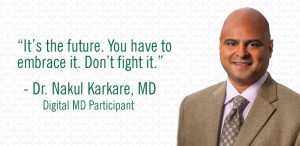As healthcare moves toward a value-based care approach in which providers are paid and rewarded for improved outcomes and cost efficiency, patient engagement efforts are proving to be a vital component of how they’ll get there.
It might be tempting to call patient engagement a buzzword. But talk to an expert in the field and you quickly begin to realize that this is no fad and that a good patient engagement strategy goes well beyond simply providing an app or a patient portal. It’s a way of thinking when it comes to how a healthcare organization will interact with patients in meaningful ways that impact the personalization and effectiveness of their care.

“Maybe it’s too hard for them to get an appointment or long waits in the waiting room or they don’t understand information that is presented to them and don’t feel comfortable asking a follow up question,” Eastwood said, pointing to messaging apps as a potential solution that could help patients ask that follow up question, schedule an appointment or research information about low acuity care as opposed to seeing if things get worse and ending up back in an urgent care setting.
“The way to go about designing that is making it an experience where patients feel like they’re having a worthwhile interaction,” Eastwood said. “It should be easy to use, look similar to messaging applications they are familiar with and the flow of information should make sense. If they are trying to make an appointment with a specialist in one part of the field, but the application can’t read that and is sending them to different specialists, that isn’t useful and they aren’t going to use [the technology], they’ll just go back to phone calls or trips to the emergency room.
Patients need to have questions answered in a way that they understand. This is an area where it’s vital to conquer what you might call the patient-developer divide. In other words, what is familiar for a developer of the software isn’t necessarily familiar for the person using it. Terminology, color choices and even typeface are all examples of things that need to be neutral in order to make an interface that doesn’t turn patients away.
Messaging apps are a particular area of interest for Eastwood, one he believes is “often overlooked in patient engagement initiatives.” The key, he says, is distinguishing what it will be used for and finding ways to give it an application within the clinical workflow. In other words, is it a customer service tool that complements a call center or is it meant to answer care questions?
New poll, new choices! As a frequent patient, what #telehealth feature would be most beneficial to you?
(Same deets: For upcoming report, based on broad definition o’ telehealth.) Feel free to comment, too.#wtfix #HITsm #hcldr #patientchat
— Brian Eastwood (@Brian_Eastwood) June 4, 2018
“It’s been demonstrated to be very effective for offering reminders, for allowing patients to communicate, particularly if they have some of those non-pressing low acuity types of questions or if they have administrative questions,” Eastwood said, noting that the chatbot style approach requires a built-in ability to recognize when a patient needs to share information and move them to a secure channel.
“Then there’s the text/SMS type messaging and that’s more about opening up communication between physicians and patients,” he said. “It’s not patients texting the staff directly, it’s them communicating through their phone so the provider has the information at the point of care. It’s an enterprise level information sharing system that is built into communication systems they’re already using. It could be in their EHR inbox, for example.”
Commercial Health Applications
Much has been made of the usefulness and data collected by commercial health applications such as fitness trackers, wearables and other internet of things connected devices. But the reliability of the data they collect and therefore the app’s ability to manipulate an outcome is something that often comes into question. Its efficacy has to be demonstrated through research and it helps if an accrediting body such as the Food and Drug Administration can endorse its clinical utility.
“One thing I’ve seen some institutions do is they will have a series of apps or services they endorse themselves,” Eastwood said. “They will say to their physician staff, ‘We recommend you use these apps with patients with asthma or type 2 diabetes,’ rather than letting the patient run wild on the app store. You say these are the apps we’ve vetted as an organization, they’ve demonstrated clinical outcomes, the data they collect has clinical value and can be used by our teams to make recommendations on a care plan. That way, patients don’t have to do that work of scrutinizing an app.”
Educating the Patient
Engagement efforts also are being aimed at helping educate patients on aspects of their care where they can have a greater influence on the outcome. One aspect of education efforts that is cultivating significant interest is initiatives that are pre-emptive rather than post diagnosis or after they’ve been discharged from the hospital, which currently represent the most common time for the patient to receive educational materials.
One example that Eastwood outlined in a recent blog post on the Chilmark site comes from HealthEast Care System, which automatically enrolled patients undergoing total joint replacement in an email and text message based educational program. Topics covered included pre-surgery preparation and post-surgery recovery. As a result, cancellations on the day of the procedure, 30-say readmissions and length of stay all decreased.
“From the hospital perspective, this is an example of streamlining operations and improving patient satisfaction,” Eastwood said. “They get fewer people coming in that didn’t know they weren’t supposed to eat or needed to stop their medication, so they have fewer procedures that need to be rescheduled. These educational models have the potential to make the patient experience before and after the process better so that they are less likely to come back into the hospital.”
The biggest areas of success in patient engagement efforts thus far have been related to high cost procedures. The next step, however, is to have an impact in helping prevent people from developing chronic conditions. As healthcare organizations accept more financial risk, Eastwood expects there will be additional incentives for identifying patients who are at risk of developing those conditions and helping them avoid that diagnosis in the future.
“A lot of companies are trying to gain a foothold there and produce not just educational products but also care coordination interactions that help patients in working with their care teams to understand the steps they need to take to avoid a preventable chronic condition,” he said.
Engagement in Value-Based Care
As a result of value-based care initiatives, there is an opportunity to rethink patient engagement and get away from service and administrative oriented metrics such as medication adherence and following a doctor’s orders.
“There’s potential there to address some of the social determinants and barriers to care that might prevent patients from coming into the hospital at certain times, or taking medication as directed or adhering to an activity or exercise plan a doctor might have recommended,” Eastwood said.
Helping patients better understand their conditions and how to manage them will, in theory, lead to fewer doctor’s office visits and more care in low acuity settings. That may come through employing more community health workers to see patients at community clinics or providing applications and devices to monitor their care instead of requiring in-person follow up appointments.
“Not all solutions involve technology,” Eastwood said. “But we need to use everything we can to keep them (patients) involved in their care. Not just in single care episodes, but in between so that we can help patients think about the ways they manage the conditions they have or mitigate some of those symptoms if it’s a condition they’re at risk of. The provider organizations don’t have to only see them within the physical facility to see how they’re doing and whether they’re making progress.”




